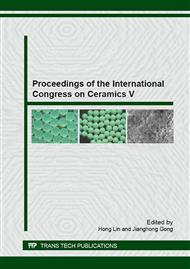[1]
S. Stolarz. Wysokotopliwe związki i fazy, Katowice: Wydaw. Śląsk, (1973).
Google Scholar
[2]
S. Prochazka. The Role of Boron and Carbon in the Sintering of Silicon Carbide. Special Ceramics vol. 6. British Ceramic Research Association. Stoke-on–Trent (1975) 171-182.
Google Scholar
[3]
L. Stobierski. A. Gubernat. Sintering of Silicon Carbide I. Effect of Carbon. Ceramics International 29. 3 (2003) 287-292.
DOI: 10.1016/s0272-8842(02)00117-7
Google Scholar
[4]
M. S. Koval'chenko, N. N. Sereda, Sintering of titanium carbide base cermets, Soviet Powder Metallurgy and Metal Ceramics, Volume 7, Issue 1, (1968) 13-17.
DOI: 10.1007/bf00776102
Google Scholar
[5]
L. He, Y. Liu, B. Li, H. Cao, J. Li, Reaction synthesis of in situ vanadium carbide particulates reinforced iron matrix composites by spark plasma sintering, J Mater Sci (2010) 45: 2538–2542.
DOI: 10.1007/s10853-010-4295-9
Google Scholar
[6]
S. C. Zhang, G. E. Hilmas, W. G. Fahrenholtz, Zirconium Carbide–Tungsten Cermets Prepared by In Situ Reaction Sintering, Journal of the American Ceramic Society, Volume 90, Issue 6, (2007) 1930–(1933).
DOI: 10.1111/j.1551-2916.2007.01642.x
Google Scholar
[7]
M.R.R. Pasotti, A. H. A. Bressiani, Jose´C. Bressiani, Sintering of alumina-niobium carbide composite, International Journal of Refractory Metals and Hard Materials, Volume 16, Issues 4–6, (1998) 423–427.
DOI: 10.1016/s0263-4368(98)00053-5
Google Scholar
[8]
S.R. Bakshia, V. Musaramthotaa, D. Lahiria, V. Singhb, S. Sealb, A, Agarwala, Spark plasma sintered tantalum carbide: Effect of pressure and nano-boron carbide addition on microstructure and mechanical properties, Materials Science and Engineering: A, Volume 528, Issue 3, (2011).
DOI: 10.1016/j.msea.2010.10.009
Google Scholar
[9]
E. Pop, V. Varshney, A. K. Roy, Thermal properties of graphene: Fundamentals and applications, MRS Bull. 37, 1273 (2012).
DOI: 10.1557/mrs.2012.203
Google Scholar
[10]
http: /chemicalengineeringnews. org/what-is-the-electrical-resistance-of-a-graphene-sheet-at-room-temperature/).
Google Scholar
[11]
C. L Xiaoding Wei, J. W. Kysar, J. Hone, Measurement of the Elastic Properties and Intrinsic Strength of Monolayer Graphene, Science, Vol. 321 no. 5887, (2008) 385-388.
DOI: 10.1126/science.1157996
Google Scholar
[12]
http: /www2. dupont. com/Kevlar/en_US/assets/downloads/KEVLAR_Technical_Guide. pdf.
Google Scholar
[13]
European Standard EN 623-2: 1993 Advaced technical ceramics – Monolithic ceramics – General and textural properties – Part 2 – Determination of density and porosity.
DOI: 10.3403/00317278
Google Scholar
[14]
P. Wyżga, P Klimczyk, P Figiel, J.L. Lukasik, M Podsiadło, K Wojteczko, Investigation of the effect of pressure, electric discharge, microwave on the microstructure and properties of sintered ceramic materials, including nanoparticles, Statutory activity grant of Institute of Advanced Manufacturing Technology (DS-12. 3. 4).
Google Scholar


